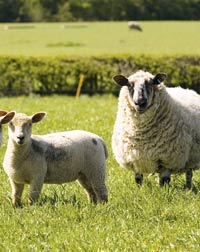How to prevent ewe mastitis at weaning

A thorough management routine, appropriate dry ewe therapy and a clean environment are essential to prevent ewe mastitis at weaning.
Management at drying off is key to preventing mastitis in your flock, says vet Matt Colson. “The feet and udder should be routinely checked at drying off – do not leave these checks until tupping. Once animals are dry, the udder enters a resting stage and it is more difficult to identify udder damage.”
A clean environment is also essential. “Grazing ewes on bare pasture can be an effective means of drying of, but ensure sheep are not over-stocked. Tight stocking can create problems with environmental contamination and infection.”
Paul Roger, specialist sheep vet, also stresses the environmental influence on mastitis. “When the udder is cold and wet or hot and wet, mastitis can be a real issue. At drying off, reduce the water intake from forage – prevent ewes from taking on lush grass by housing on a clean straw yard with limited feed and ad-lib water for 24 hours.”
“This is the time where dry ewe therapy can be used.”
According to Mr Colston, dry cow tubes can be a viable option in certain circumstances. “Dry cow tubes can be very effective for controlling mastitis in sheep. However, they are not licensed for this use and must only be used after speaking to your vet.”
Preparation is key to preventing ewe mastitis, says John Vipond, SAC sheep specialist. “We have seen a marked increase in the number of mastitis cases reported by Scottish sheep farmers this season.”
“A number of factors pre-dispose these issues,” says Mr Vipond. “Immunity suppression in late pregnancy is one of them.”
To counteract this natural dip in immunity, ration protein levels should be assessed in the last three weeks of pregnancy. “We already know supplementary soya can decrease egg counts and improve colostrum quality, but it could also act to reduce mastitis. Aim to feed about 100g of soya a ewe each day for lowland ewes.”
